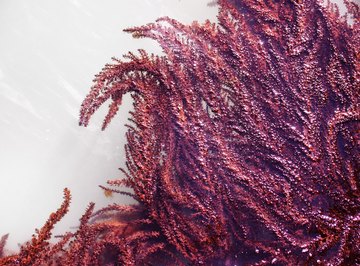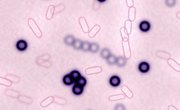
The life cycle of algae depends on the type of algae, and there are four main patterns of life cycles in algae. All four patterns exhibit an alternation of generations, which means that there are distinct haploid and diploid stages. In all cases, the haploid stage is referred to as the gametophyte, and the diploid stage is called the sporophyte.
Haploid means that the organism has only one set of chromosomes, and is often noted as "n." In contrast, diploid organisms have two sets of chromosomes, one from each parent, and the shorthand "2n" is used for this stage. The four main types of life cycles in algae are haplontic, diplontic, diplohaplontic and triphasic.
Haplontic Life Cycle of Algae
The haplontic life cycle is also called monogenetic. In this type of life cycle, the only diploid part of the cycle is the zygote. The plant body is a gametophyte in those algae that exhibit a haplontic life cycle.
In this type of life cycle, the diploid zygote produces four meiospores through meiotic division. After germination, these four meiospores become haploid gametophyte plants.
Examples of a haplontic life cycle of algae can be seen in green algae like Spirogyra and Zygnema. The life cycle of Chlamydomonas, which is a genus of green algae, is also haplontic.
Diplontic Life Cycle of Algae
In the diplontic life cycle of algae, only the gametes are haploid. The plant body is a sporophyte, and sex organs on the sporophyte produce gametes. The predominant stage in this type of life cycle is the multicellular, diploid plant body.
Gametes are produced by meiosis in the sex organs of the sporophyte, and the zygote is formed immediately after fertilization. Examples of a diplontic life cycle of algae are exhibited in brown algae in the genera Fucus and Sargassum.
Diplohaplontic Life Cycle of Algae
In the diplohaplontic life cycle, the haploid and diploid stages are equally prominent. Both stages produce vegetative plants, which differ only in function and chromosome number.
The diploid sporophyte reproduces asexually, while the haploid gametophyte reproduces through a sexual process. An alternation of generations is accomplished through the fusion of gametes and meiosis in sporophytes.
There are two distinct types of diplohaplontic life cycles. The first is called isomorphic or homologous, and the second is referred to as heteromorphic or heterologous.
In an isomorphic or homologous diplohaplontic life cycle, the main characteristic is that the gametophytic and sporophytic plants are morphologically similar, meaning their form is alike. Also, both stages in this type of life cycle are free living, meaning they are independent from one another. Examples of this type of life cycle are found in green seaweeds in the genera Cladohora and Ulva.
In the second type of diplohaplontic life cycle, heteromorphic or heterologous, the gametophytic and sporophytic plants are morphologically different. In most cases, the sporophytic plant is complex, while the gametophyte is simple. Brown seaweeds in the genus Laminaria exhibit a heteromorphic or heterologous diplohaplontic type of life cycle.
Triphasic Life Cycle of Algae
The triphasic life cycle of algae is unique because instead of two generations, there are three separate generations. There are two types of triphasic life cycles of algae: haplobiontic and diplobiontic.
The main difference between these two types of triphasic life cycles is that there are two haploid generations and one diploid generation in the haplobiontic kind, while there are two diploid generations and one haploid generation in the diplobiontic type of life cycle.
In the haplobiontic type of life cycle, the haploid gametophytic phase is dominant. In contrast, the diploid sporophyte is the dominant phase in a diplobiontic triphasic life cycle. An example of this type of life cycle can be seen in red algae in the genus Polysiphonia.
References
About the Author
Meg Schader is a freelance writer and copyeditor. She holds a Bachelor of Science in agriculture from Cornell University and a Master of Professional Studies in environmental studies from SUNY College of Environmental Science and Forestry. Along with freelancing, she also runs a small farm with her family in Central New York.
